Product Resources
Product Resources
FT-IR spectrometer
The Exoscan FT-IR spectrometer from A2 Technologies is designed for laboratory and field use. Sampling interfaces for the instrument include internal reflectance, grazing angle reflectance, diffuse reflectance, and specular reflectance. Applications include liquids, powders, pastes, and reflective and nonreflective solids. The spectrometer can be used as a handheld, battery-operated instrument or, with an optional docking station, as a laboratory bench-top system. A2 Technologies, Danbury, CT; www.a2technologies.com

ICP-MS system
The 7700 Series ICP-MS system from Agilent Technologies is designed to be simple to operate and to provide data integrity in trace element analysis. According to the company, the system occupies 73 cm of bench space. The instrument features the company's ICP-MS MassHunter software. Agilent Technologies, Santa Clara, CA; www.agilent.com

Integrating sphere with light source
Avantes' AvaSpere-50-LS-HAL integrating sphere with an internal halogen light source can be used for reflection measurements with diffuse halogen light as illumination. It is designed to be used with the company's AvaSpec spectrometers. According to the company, the internal light source provides 160 times more light on the sample than with an integrating sphere with an external fiber-coupled light source. The device has an internal diameter of 50 mm, a sample port diameter of 10 mm, and an SMA terminated reference port. The 5-W halogen lamp is stabilized and cooled with forced air flow. A 24-V, 1.25-A power supply is included. Avantes, Inc., Broomfield, CO; www.avantes.com

Visible-NIR Raman spectral engine
The Visible-NIR Raman spectral engine from BaySpec has a wavelength range of 300–1100 nm. The instrument can be used for Raman illuminated analyses at various wavelengths from 300 nm to 800 nm for Raman spectroscopy. According to the company, the instrument's 2048 × 64 pixel CCD array achieves a typical resolution of 5 cm–1 . The instrument uses a VPG transmission grating and reportedly is calibrated for life. BaySpec, Inc., Fremont, CA; www.bayspec.com

FT-IR laboratory spectrometer
The MB3000 FT-IR analyzer from ABB is designed for ease of use, reliability, and constant results. The instrument is available in two versions: the MB3000 for mid-IR analyses and the MB3600 for near-IR applications. The instrument can be combined with the company's Horizon MB software for data acquisition, processing, and analysis. ABB Analytical, Lewisburg, WV; www.abb.com
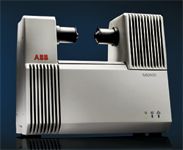
FT-IR microscope
The Nicolet iN10 MX FT-IR microscope from Thermo Fisher Scientific is designed for high-speed imaging, increased accuracy, and ease of use. The instrument incorporates the infrared optics in a single, integrated system, which reportedly improves sampling and enables the use of a room-temperature IR detector and reduces bench space. According to the company, the microscope can be used to analyze samples as small as 3–4 μm for single-point analyses and mapping or chemical imaging analyses. Thermo Fisher Scientific, Inc., Madison, WI; www.thermo.com/ftir

Sequencing software
SeqLab de-novo sequencing software from Shimadzu Scientific Instruments is designed for use with the company's AXIMA MALDI mass spectrometers. According to the company, researchers can use MS-MS to find de-novo sequences and tags for peptides and related MS-MS-MS data to help decipher peptide sequences. Shimadzu Scientific Instruments Inc., Columbia, MD; www.ssi.shimadzu.com

Handheld XRF analyzer
The S1 TURBOSD handheld XRF analyzer from Bruker AXS is designed for mining applications ranging from exploration and survey to final processing. The analyzer can be used for on-site geochemical analysis of mine face, drill core, or prepared samples. The instrument's mining calibration reportedly compensates for interelement issues that can affect analysis results. According to the company, it can be used with sample concentrations ranging from 100 ppm to greater than 50%. Bruker AXS, Inc., Madison, WI; www.brukerhandheldxrf.com

CCD spectrometers
Econic CCD spectrometers from B&W Tek are designed for academic and government teaching laboratories. The spectrometers include a 2000-element linear CCD array, a fiber-coupled spectrograph, a built-in 16-bit digitizer, and a USB 2.0 interface. Standard wavelength ranges are 250–950 nm and 350–1050 nm with a standard slit size of 25 mm, reportedly delivering a resolution of 0.8–10 nm depending on configuration. The instruments include external event synchronization, external trigger input, and the company's BWSpec software. B&W Tek, Newark, DE; www.econic.bwtek.com
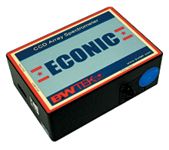
Vertical diode laser stacks
Quasi-continuous-wave (QCW) high-power vertical diode laser stacked arrays from DILAS reportedly are available in wavelengths ranging from 808 nm to 9xx nm with power ranges up to 300 W QCW per bar with optional fast-axis collimation. The AuSn soldered vertical stacks are designed for operation at high temperatures in applications such as diode pump solid-state laser and defense requiring QCW lasers in the kilowatt power range. The conduction-cooled stacks are available in one-bar, seven-bar, and eight-bar configurations. DILAS, Mainz, Germany; www.dilas.com

Fiber-optic vacuum feedthrough
Fiberguide Industries' fiber-optic vacuum feedthroughs are available in unlimited cell, flange, and port designs. The feedthroughs reportedly can be used at temperatures as high as 175 °C (250 °C for pigtail) using the company's gold-coated fiber. Fiber selection includes Multimode, Single Mode, and Polarization Maintaining with core diameters ranging from 50–1500 μm and connector interface selections of SMA (standard), ST, FC, and ferrule style. According to the company, the fibers are helium leak-tested and certified to 10–7 torr. Fiberguide Industries, Stirling, NJ; www.fiberguide.com
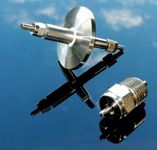
Small-volume cuvette
The TrayCell cuvette from Hellma is designed to be used with a sample volume of 0.7 μL. According to the company, the cuvette uses the surface tension of the sample to form a repeatable optical path of 0.2 mm or 1 mm. The cuvette reportedly can be inserted in any standard spectrophotometer's cuvette holder. The lower part contains fiber optics and mirrors that interface to an upper part that contains collimating optics. Hellma USA, Plainview, NY; www.hellmausa.com

Hyperspectral imaging system
The HIS Examiner 100 QD hyperspectral imaging system from ChemImage is designed for the examination of questioned documents. The optical-based forensic document imaging system can be used to detect forgeries and alterations, visualize hidden security features, and examine travel documents. The system reportedly is based on liquid crystal filter technology and uses reflected, transmitted, or emitted light from each point in a sample image to create chemical-based contrast within the image. ChemImage, Pittsburgh, PA; www.chemimage.com

Optics catalog
Edmund Optics' Biotech Optics catalog includes more than 16,900 products for researchers and developers in biotech research, development, and production. The catalog lists products such as ultrasharp longpass filters for Raman spectroscopy, UV-NIR triplets for two-photon excitation microscopy, and aspherized achromats for retinal photocoagulation. Edmund Optics, Barrington, NJ; www.edmundoptics.com/catalogrequest

Ceramic ICP nebulizer
Glass Expansion's VeeSpray ceramic nebulizer is designed for use in ICP emission and mass spectrometers. According to the company, the nebulizer has easy-to-change sample and gas lines and can tolerate samples containing particles, high concentrations of dissolved solids, and hydrofluoric acid. Glass Expansion, Pocasset, MA; www.geicp.com

Vacuum UV spectrophotometer
McPherson's Vacuum UV Analytical Spectrophotometer (VUVAS) system is designed to measure transmission and reflectance from 120 nm to 400 nm to within 0.3% in vacuum or with inert gas purge. Applications include thin-film or material characterization and, with an optional polarizer, the spectrophotometer can check S and P response as well. The instrument reportedly can accommodate samples smaller than 350 mm in diameter in solid, liquid, or gas phase with optional holders or sample chamber configurations. According to the company, the vacuum-compatible system simultaneously collects sample and reference spectra. McPherson, Inc., Chelmsford, MA; www.mcphersoninc.com
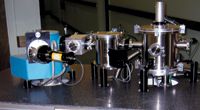
Pyroelectric detectors
Pyroelectric detectors from Microwatt Applications include detectors for use with FT-IR and with NDIR. The MWA 5500 series detectors, for use with FT-IR, are single element DLATGS detectors with spectral sensitivity ranging from the UV to 1000 μm. The MWA 4000 series detectors, for use with NDIR, are single-element permanently poled lithium tantalate detectors that can be operated from 1 Hz to 100 Hz. Microwatt Applications, Boynton Beach, FL; www.microwattonline.com

Air-jet sieve
The AS 200 Jet air-jet sieve is designed for separating light, fine particle sizes. The sieve is intended for use with 203-mm (8-in.) diameter sieves as small as 10 μm (~1200 mesh). According to the company, an industrial vacuum generates a jet of air that evenly disperses the particles via a slotted nozzle. The material that passes through the sieve is either discarded through the vacuum or collected in an attached cyclone. The procedure reportedly requires 2–3 min. Retsch, Inc., Newtown, PA; www.retsch-us.com

RoHS/WEEE check standard
An RoHS/WEEE check standard from SPEX CertiPrep contains Br, Pb, Hg, Cr, and Cd in a polyethylene matrix. The standard comes in a 25-g size. The certified reference material is designed for use in analyzing toxic materials in plastic. SPEX CertiPrep, Inc., Metuchen, NJ; www.spexcsp.com

ICP spectrometer
Thermo Fisher Scientific's iCAP 6200 ICP spectrometer is a dual-view ICP instrument designed for routine analytical laboratories. According to the company, the spectrometer provides a range of pre-optimized sample introduction settings and can handle low to moderate sample numbers in application areas such as environmental, food and beverage, toy safety, and WEEE/RoHS testing. The instrument's purge gas distribution system reportedly is designed for reduced gas consumption. The instrument is supplied with preloaded method templates. Thermo Fisher Scientific, Inc., Cambridge, UK; www.thermo.com/icap

Optical sensing device
The Jaz optical sensing device from Ocean Optics is based on a miniature CCD-array spectrometer and is designed to integrate multipoint spectral sampling and reference monitoring into process streams and other sample environments. The modular, stackable device includes a microprocessor and display that reportedly allows acquisition, processing, and storage of full spectra data without a PC. Spectral data can be transferred to a laptop or desktop PC for additional postacquisition processing. Ocean Optics, Inc., Dunedin, FL; www.oceanoptics.com

EDXRF spectrometer
Shimadzu Scientific Instruments' EDX-GP energy dispersive X-ray fluorescence spectrometer is designed for fast, high-sensitivity measurements with automatic operation for first-time users. According to the company, the spectrometer provides optimal filters are automatically selected and high-speed mode conditions are installed by default to allow batch measurements of RoHS/ELV hazardous elements using a single filter. Other automated procedures include instrument start-up and calibration. The instrument's software reportedly features a measurement time reduction function for samples containing no hazardous elements. Shimadzu Scientific Instruments Inc., Columbia, MD; www.ssi.shimadzu.com

Raman microscope
HORIBA Scientific's XploRA Raman microscope is designed to combine microscopy and chemical analysis for use in R&D, QA/QC, and forensic laboratories. According to the company, the instrument performs nondestructive analysis at atmospheric conditions with no sample preparation. Software modules include a Guided Operation wizard. HORIBA Scientific, Edison, NJ; www.horiba.com/scientific

Raman microscope
The μSense-I Raman microscope from Enwave is designed for nonconfocal microscopic Raman applications in academic, industrial, and research laboratories. The microscope reportedly provides a spectral resolution of –6 cm–1 , a spectral range of ~250–2350 nm, and spatial resolution of better than 5 μm. The instrument's Raman unit can be detached from the microscope and used as a portable instrument. Enwave Optronics, Inc., Irvine, CA; www.enwaveopt.com
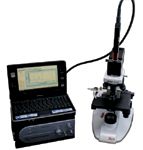
FT-IR spectrometer
PerkinElmer's Spectrum 100S FT-IR spectrometer is designed for identifying and validating raw materials and examining the properties and performance of novel materials and their component parts. According to the company, the spectrometer's sensitivity allows it to be used to analyze materials that previously required a specialized detector and reduces analysis times by as much as 50% for most routine applications. PerkinElmer, Inc., Shelton, CT; www.perkinelmer.com

Fluorescence measurement system
Hitachi's Quantum Yield measurement system for the company's model F-7000 fluorescence spectrophotometer is designed for fast measurements and calculations of internal and external QY, absorption, absorption amount, and fluorescent amount of powder samples. The system includes the accessories required for spectral correction and quantum yield measurements in the range of 240–800 nm. Hitachi High Technologies America, Inc., Pleasanton, CA; www.hitachi-hta.com

Spectroscopy modeling software
Photon Engineering's FRED Optimum software is designed for modeling all types of spectroscopic systems. The 3D CAD optical engineering software can simulate the propagation of light through any optical–illumination system modeling source radiative phenomena and arbitrary optomechanical geometry with algorithms to model fluorescence, polarization, interference, scatter, diffraction, transmission, reflection, and absorption at any surface. Photon Engineering, LLC, Tucson, AZ; www.photonengr.com

ATR accessory
The GladiATR Vision attenuated total reflection device is designed to couple small-area infrared analysis with simultaneous viewing. According to the company, the device's diamond crystal enables analysis of thick or nontransparent samples. The accessory reportedly is compatible with most FT-IR spectrometers. Pike Technologies, Madison, WI; www.piketech.com

LIBS systems
Laser induced breakdown spectroscopy (LIBS) systems from Applied Spectra are available for field and laboratory use. The field-portable PL100-GEO and the RT100 Series laboratory equipment LIBS instruments reportedly provide detection sensitivity at the low parts-per-million level and can detect lighter elements such as Li, Be, B, N, O, Na, and Mg. According to the company, the instruments eliminate sample preparation and toxic chemical wastes generated from acid dissolution of samples. Applied Spectra, Inc., Fremont, CA; www.appliedspectra.com

ICP–AES method development
HORIBA Scientific's CLIP (collection of line intensity profiles) is designed to assist analysts in the development of methods for high-resolution sequential ICP–atomic emission spectroscopy. According to the company, the profile of each line is calculated according to the instrument's configuration, including focal length, slit combination, diffraction grating, and order used. The product is available as an upgrade module for the company's ULTIMA instrument. HORIBA Scientific, Edison, NJ; www.horiba.com

Mercury analyzer
The Hydra IIAA automated mercury analyzer from Teledyne Leeman Labs is designed to provide 1 ppt detection limits and fast sample throughput. The instrument includes a 270-position autosampler. According to the company, the instrument's software automates the analytical process from method development to final report generation. The analyzer reportedly can be upgraded to perform direct solids analysis. Teledyne Leeman Labs, Hudson, NH; www.LeemanLabs.com

Neutral density filters
Circular variable neutral density filters for laser applications such as multiphoton microscopy and ultrafast spectroscopy are available from Newport Corporation. The filters include a metallic coating on a 2-mm fused-silica substrate and reportedly can be used with short pulses. The filters are available in multiple sizes and optical density variations and are designed to attenuate low energy laser light in the 200–2000 nm range. Newport Corporation, Irvine, CA; www.newport.com


LIBS Illuminates the Hidden Health Risks of Indoor Welding and Soldering
April 23rd 2025A new dual-spectroscopy approach reveals real-time pollution threats in indoor workspaces. Chinese researchers have pioneered the use of laser-induced breakdown spectroscopy (LIBS) and aerosol mass spectrometry to uncover and monitor harmful heavy metal and dust emissions from soldering and welding in real-time. These complementary tools offer a fast, accurate means to evaluate air quality threats in industrial and indoor environments—where people spend most of their time.
NIR Spectroscopy Explored as Sustainable Approach to Detecting Bovine Mastitis
April 23rd 2025A new study published in Applied Food Research demonstrates that near-infrared spectroscopy (NIRS) can effectively detect subclinical bovine mastitis in milk, offering a fast, non-invasive method to guide targeted antibiotic treatment and support sustainable dairy practices.
Smarter Sensors, Cleaner Earth Using AI and IoT for Pollution Monitoring
April 22nd 2025A global research team has detailed how smart sensors, artificial intelligence (AI), machine learning, and Internet of Things (IoT) technologies are transforming the detection and management of environmental pollutants. Their comprehensive review highlights how spectroscopy and sensor networks are now key tools in real-time pollution tracking.